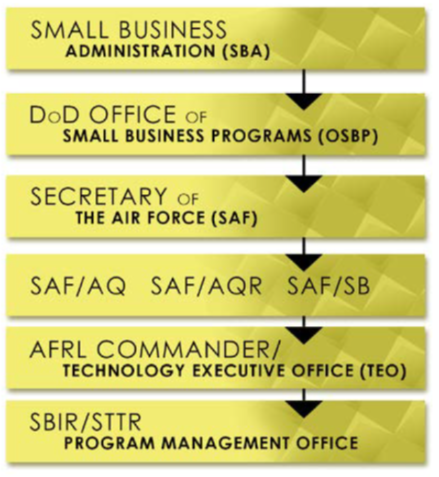USING SBIR?

Small Business Innovative Research (SBIR) and Small Business Technology Transfer (STTR) Phase III Contract Opportunities

POC: Jonathan Foster, AFSC/ENRB
Air Force SBIR Program Manager (Robins AFB)
478.926.4627
Email: jonathan.foster.10@us.af.mil
DISTRIBUTION STATEMENT A. Approved for public release. (19 Aug 2019).
Outline
Purpose
I. Identifying SBIR/STTR (hereafter, “SBIR”) Phase III Opportunities
III. SBIR Phase III Authorities
IV. Frequently Encountered Issues in SBIR Phase III Formations
V. Wisdom for Phase III Formations
Endnotes
Purpose
Purpose of the briefing: to entertain and educate government, industry, and academic scientists, engineers, and others about i.) the attributes of SBIR Phase III contracts and ii.) how to take advantage of the same.
————————————————————————
I. Identifying SBIR/STTR Phase III Opportunities
Legal definition: “Phase III refers to work that derives from, extends, or completes an effort made under prior SBIR/STTR Funding Agreements, but is funded by sources other than the SBIR/STTR programs. Phase III work is typically oriented towards commercialization of SBIR/STTR research or technology, including through further R/R&D work.”1, 2, 3, and 4
Lay definition: a Phase III contract opportunity arises whenever a technology was formerly developed through SBIR funding and now someone wishes to purchase or continue to advance that same technology with non-SBIR funding.
Note: “SBIR Phase III” does not bear any relation to 1.) the maturity (TRL) of technology nor 2.) the origination or culmination of a SBIR Phase II contract.
Example:
- A technology was fruitfully developed by the Air Force through SBIR funding under SBIR topic AF081-101, ‘Development of Cad Plating Replacement with Alkaline Zinc-Nickel (Zn-Ni) Electroplating for Threaded Fasteners/Components,’ with a particular Small Business Concern (SBC).
- The Air Force (402nd Commodities Maintenance Group {402nd CMXG}) desired to purchase zinc-nickel plating production services from the SBC.
- Since i.) the sought-after service involved the zinc-nickel plating process (technology) developed by the SBC through SBIR topic AF081-101 and ii.) 402nd CMXG possesses non-SBIR funding allowing for the provision of materiel production services, then a SBIR Phase III contract opportunity was present.
- Resultantly, a SBIR Phase III indefinite-delivery, indefinite-quantity (IDIQ) contract was formed for the SBC to provide zinc-nickel plating services to 402nd CMXG on an as-needed, delivery-order basis.
Conveniently, SBIR Phase III contracts may be awarded on a sole source basis.5
- In fact, when a particular technology has been developed under SBIR funding, the Air Force or other agencies shall award SBIR Phase III contracts for the acquisition of that technology to the greatest extent practicable.
- Furthermore, when a technology has been developed through SBIR funding and the Air Force intends to award a contract for that same technology (e.g., material, mechanism, service, etc.) to someone other than the SBIR-funded technology developer, they must put the U.S. Small Business Administration (SBA) on informed notice of such decision; the SBA may subsequently appeal this decision to the awarding agency’s highest office whenever SBA sees fit to do so.
- Stating that the contract is a SBIR Phase III contract is sufficient for meeting any J&A requirement.
- There is no publication requirement for Phase III awards.9 That is, FAR 5.202(a)(7) (Synopses of Proposed Contract Actions: Exceptions) applies to Phase III SBIR contracts.
- There is no limit on the number, duration, type, or dollar value of Phase III awards made to a business concern.
- A Phase III contract may be made for any type of acquisition (products, production, services, research or research and development, or any such combination thereof) and utilize any type of non-SBIR funding, so long as the type of funding matches the nature of the underlying acquisition.
Conclusion: contract award lead times and source selection risks can be drastically reduced when Phase III opportunities arise.
III. SBIR Phase III Authorities
The Small Business Administration is the coordinating agency for the SBIR program for all U.S. agencies and departments.
- It directs all agencies’ implementation of SBIR, reviews their progress, and reports annually to Congress on its operation.
- SBA is also the information link to SBIR.
- SBA collects solicitation information from all participating agencies and publishes it quarterly in a Pre-Solicitation Announcement (PSA).

AFRL/SB, Office of SBIR/STTR Contracting, establishes contracting policies and guidance for Air Force SBIR/STTR contracts.
- AFRL/SB interprets and advises on the implementation of statutory, directive, instructional and policy guidance from Congress, SBA, DoD, Air Force and other authorities.
- AFRL/SB appoints an Air Force SBIR/STTR Lead Contracting Officer who, for example, leads Air Force SBIR/STTR contracting activities including contracting information questions.
IV. Frequently Encountered Issues In SBIR Phase III Contract Formations
“We aren’t using SBIR money here, therefore we can’t create a SBIR contract.”
Not true. Explanation – see part I. above.
“We aren’t doing R&D, therefore we can’t create a SBIR contract.”
Not true. Explanation – see part I. above.
“We have to compete this.”
Not true. Explanation – part II. above.
“We have to write a J&A; you need to write J&A.”
Not true. Explanation – part II. above.
“We need to first publish our intent to award this contract.”
Not true. Explanation – part II. above.
V. Wisdom for Phase III Formations
1. Involve your (or a) SBIR program manager (PM) early and often.15
SBIR PM’s are networked to other SBIR PM’s and freely share access to information and authorities.
2. Anticipate the nodes of approval and their respective questions along the budget authorization (BA) and purchase request (PR) circuits.
Proactively approach these nodes and inform them about Phase III’s in general as well as your present Phase III ambitions that are en route.
3. Prepare responses beforehand to the types of questions and comments that you know you will most likely receive.
Refer to parts I. and II. above.
4. Prepare to answer the same questions multiple times for multiple offices over protracted periods of time.
5. Prepare to go all the way.
Site and involve an AF SBIR PM as needed.
Sometimes all that’s needed for the decision-maker is raw information from an additional source.
Site and involve the AF SBIR contracting lead.
Sometimes all that’s needed for the decision-maker is another contracting reference/POC explaining Phase III privileges and preferences.
Appeal to contracting supervisor’s and higher contracting leaderships’ attention.
Higher levels of contracting officers frequently have prior experience with SBIR’s.
Appeal to SBA.
The SBA can appeal decisions to not grant Phase III privileges or preferences. The light of review will likely show the path of least resistance.
Conclusion:
Once an organization routes Phase III requests along one BA and PR path to successful contract award, subsequent Phase III requests will notionally go smoother along the same and possibly other similarly situated BA and PR routes.
1. Small Business Innovation Research (SBIR) and Small Business Technology Transfer (STTR) Program Policy Directive (May 2, 2019), section (4)(c).
2. “[The SBIR/STTR Policy Directive] fulfills [The Small Business Act]’s statutory obligation to provide guidance to [] participating Federal agencies for the general operation of the SBIR and STTR programs. Because most of the policy for the SBIR and STTR program is the same, SBA issues a single Policy Directive for both programs.” Id., (1)(b).
3. “Federal agencies participating in [SBIR/STTR] programs [] are obligated to follow the guidance provided by this Policy Directive.” Id., (1)(e).
4. “SBIR/STTR-derived products or services intended for use by the Federal Government funded by non-SBIR/STTR sources of Federal funding” or “continuation of SBIR/STTR work, funded by non-SBIR/STTR sources of Federal funding including R/R&D.” Id., (4)(c)(1)(ii) and (iii).
5. “The competitions for SBIR/STTR Phase I and Phase II awards satisfy any competition requirement of the Armed Services Procurement Act, the Federal Property and Administrative Services Act, and the Competition in Contracting Act. An agency that wishes to fund an SBIR/STTR Phase III award, which is an extension of prior Phase I and/or Phase II awards, is not required to conduct another competition for the Phase III award in order to satisfy those statutory provisions.” Id., (4)(c)(3).
6. “Agencies . . . that pursue research or research and development (R/R&D) or production of technology developed under the SBIR/STTR program shall issue Phase III awards relating to the technology, including sole source awards, to the Awardee that developed the technology under an SBIR/STTR award, to the greatest extent practicable, consistent with an Agency’s mission and optimal small business participation.” Id., (4)(c)(7).
7. “Id., (4)(c)(7)(iv) and (v).”
8. “ . . . it is sufficient to state for purposes of a Justification and Approval, if one is deemed required by the agency, that the project is an SBIR/STTR Phase III award that is derived from, extends, or completes efforts made under prior SBIR/STTR Funding Agreements and is authorized pursuant to 15 U.S.C. 638(r)(4). Further justification is not needed.” Id., (4)(c)(3).
9. “The following are exemptions from the notice publication requirements: [. . .] (iii) The SBIR/STTR Phase III award process.” Id., (2)(j)(4). Also see See FAR 5.202(a)(7) (Synopsis of Proposed Contract Actions: Exceptions) at https://www.acquisition.gov/far/5.202 or https://www.acquisition.gov/far/part-5#FAR_5_202
10. “There is no limit on the number, duration, type, or dollar value of Phase III awards made to a business concern. There is no limit on the time that may elapse between a Phase I or Phase II award and Phase III award, or between a Phase III award and any subsequent Phase III award. A Federal Agency may enter into a Phase III SBIR/STTR agreement at any time with a Phase II Awardee. Similarly, a Federal Agency may enter into a Phase III SBIR/STTR agreement at any time with a Phase I Awardee. A subcontract to a Federally-funded prime contract may be a Phase III award.” Id., (4)(c)(5).
11. “Phase III work may be for products, production, services, R/R&D, or any such combination.” Id., (4)(c)(4).
12. See https://www.sbir.gov/
13. AFI61-102, 7.4.4.1.1. and 7.4.4.1.3.
14. Id., 7.4.4.1.5.7.
15. See https://www.sbirsttr.af.mil/contact-us/contacts/
16. SBA SBIR/STTR Policy Directive, section (4)(v).
